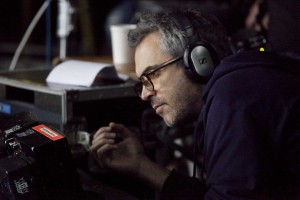
“He is my co-filmmaker. It’s a collaboration I cherish,” commented Cuarón about Emmanuel Lubezki, the director’s cinematographer on most of his films since his first feature, Sólo con tu pareja, in 1991. He continued, “Emmanuel and I, we have this almost telepathic communication. I think because we’ve known each other since we were teens. We are in sync. We explore cinema. We believe cinema is a language and we’re very intrigued about the possibilities of that language.” As he would be on a regular movie set, Lubezki was in charge of the lighting of the film. He just used a different set of tools when dealing with the visual effects.
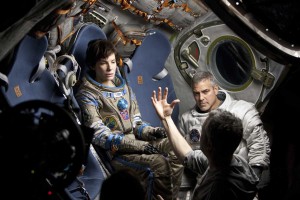 The filmmakers wanted “people to believe that they were floating in space.” Lighting was critical in achieving that goal. “Light in space is unlike any light on planet earth. All light on earth is filtered,” explained Cuarón. “In space it is absolutely unfiltered. It is harsh with hard contrast.” He also noted that the direct light in space has only one color, and that color does not change except for a few seconds in sunrise and sunset. What changes quite a lot is the color of the bounce light coming from the earth, which is dependent on the position of the earth and the location over the earth.
The filmmakers wanted “people to believe that they were floating in space.” Lighting was critical in achieving that goal. “Light in space is unlike any light on planet earth. All light on earth is filtered,” explained Cuarón. “In space it is absolutely unfiltered. It is harsh with hard contrast.” He also noted that the direct light in space has only one color, and that color does not change except for a few seconds in sunrise and sunset. What changes quite a lot is the color of the bounce light coming from the earth, which is dependent on the position of the earth and the location over the earth.
“If you are floating over Africa, then the bounce is going to be a warmer bounce because of the Sahara Desert. If you’re orbiting over the Pacific, it is going to be a cooler bounce because of the Pacific Ocean. And obviously the amount of clouds will change the quality of the bounce,” revealed Cuarón. “Emmanuel was super specific in reproducing the quality of the bounce.”
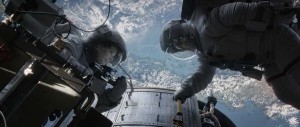 During the four-and-a-half years that it took to get the movie into theaters, the film was made three times, first during pre-visualization, then in production and finally in post. Every shot is an effects shot that had to be conceived in the pre-vis stage so that they knew exactly what had to be shot. Key crew – from cinematography and production design, to visual effects, editing, sound design and music – joined the process early on.
During the four-and-a-half years that it took to get the movie into theaters, the film was made three times, first during pre-visualization, then in production and finally in post. Every shot is an effects shot that had to be conceived in the pre-vis stage so that they knew exactly what had to be shot. Key crew – from cinematography and production design, to visual effects, editing, sound design and music – joined the process early on.
“The best way of defining that process is that we had to complete postproduction before we began pre-production,” explained Cuarón. The director, along with his co-editor, Mark Sanger, cut the whole film in pre-vis in order to program the computer systems that were going to be used in the shoot. “Once you have done all of that, you start making choices, so you are editing.” Cuarón continued, “In order to develop a better sense of that, you have to do a mix.” That mix even included music.
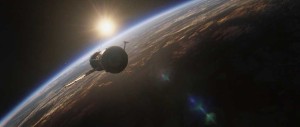 Production designer, Andy Nicholson, came on early in order not only to help create the look of the film in pre-vis, but because in order to shoot the film, the filmmakers needed very precise dimensions. Textures and colors were also critical since those textures and colors would affect the bounce light. “In pre-vis, he was already designing the sets,” revealed Cuarón. “He was designing the sets, not with wood and plank, but with a different, digital tool.”
Production designer, Andy Nicholson, came on early in order not only to help create the look of the film in pre-vis, but because in order to shoot the film, the filmmakers needed very precise dimensions. Textures and colors were also critical since those textures and colors would affect the bounce light. “In pre-vis, he was already designing the sets,” revealed Cuarón. “He was designing the sets, not with wood and plank, but with a different, digital tool.”
Even when the company got into production and practical sets were built, the line between virtual and real sets was blurred. Sometimes there would be a partial set for the actor’s interactions, but the rest would be rendered digitally. In some cases there would be a “proxy set” – a set with the exact dimensions and color for the bounce lights, but without the details. The actors had “proxy suits” with tracking sensors that they wore as a reference for interaction, where the details would be added and rendered digitally. These were also needed to achieve the right bounce light. Everything had to be exact so that when they rendered the CG, all the elements – real and virtual – would match.
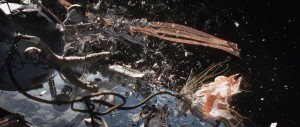 “It was super blurred,” confirmed Cuarón. “In terms of full sets, we only had the interior of the capsules. Still, obviously what you see out the window, that’s a virtual reality. And we have a bunch of different digital elements floating around in the capsules. Let me put it this way, there is not one single shot in the film that is not a visual effects shot. The film is an one-and-a-half hour visual effect.”
“It was super blurred,” confirmed Cuarón. “In terms of full sets, we only had the interior of the capsules. Still, obviously what you see out the window, that’s a virtual reality. And we have a bunch of different digital elements floating around in the capsules. Let me put it this way, there is not one single shot in the film that is not a visual effects shot. The film is an one-and-a-half hour visual effect.”
The collaboration between departments extended to working with the actors, in particular Sandra Bullock. Even in the early stage, Cuarón conferred with the actress as to her action. Any changes would in term affect the animators. She even gave notes to the animators. “It’s rare that you’re going to hear about an actor who’s having a collaboration with visual effects,” commented Cuarón. Bullock was also very aware of the tracking points on her suit, including instances when she might have blocked them and caused problems for the VFX team.
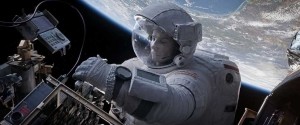 Bullock’s visor, and the virtual breath on it, was rendered digitally. This was yet another area of cross-departmental collaboration between the artists rendering the visor, the reflections of the environment on the visor that took into account the fine balance between the reflection and the expressions of the actor and the breath on the visor. “The breath is a fundamental aspect of Gravity. It is a constant presence. Breath is a character on its own,” explained Cuarón.
Bullock’s visor, and the virtual breath on it, was rendered digitally. This was yet another area of cross-departmental collaboration between the artists rendering the visor, the reflections of the environment on the visor that took into account the fine balance between the reflection and the expressions of the actor and the breath on the visor. “The breath is a fundamental aspect of Gravity. It is a constant presence. Breath is a character on its own,” explained Cuarón.
One of the luxuries of the lengthy schedule allowed for rewrites of the script based upon the editing choices that were made in pre-vis. This also became a “Catch-22” because the adjustments would then have to be made to the pre-vis. “When you do adjustments like that on set, it takes maybe three hours,” shared Cuarón. “When you do adjustments like that in pre-vis, maybe it takes you three weeks.”
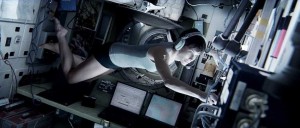 A bi-product of the extended process was that Cuarón had over four years to edit the film, which allowed the filmmakers to try different ideas, edit out parts and refine the timing. Because the sound crew – headed by sound designer and supervising sound editor, Glenn Freemantle – was brought on during pre-vis, it was possible to experiment with different choices for the audio. “They were involved in the different incarnations of the film,” said Cuarón. “And a lot of the sound choices were described in the screenplay. When you are writing the script, you try to convey the experience of watching the film as much as possible.”
A bi-product of the extended process was that Cuarón had over four years to edit the film, which allowed the filmmakers to try different ideas, edit out parts and refine the timing. Because the sound crew – headed by sound designer and supervising sound editor, Glenn Freemantle – was brought on during pre-vis, it was possible to experiment with different choices for the audio. “They were involved in the different incarnations of the film,” said Cuarón. “And a lot of the sound choices were described in the screenplay. When you are writing the script, you try to convey the experience of watching the film as much as possible.”
The sound editors collaborated with composer Steven Price who provided music early on and put a lot of time into the making of the film. Often there is a conflict between sound and music, but in this case they were in constant collaboration, according to Cuarón who said, “Sometimes I didn’t know what was music and what was effects because they worked together.”
Many members of the crew are being recognized for their groundbreaking work with craft nominations. “Not a lot of people have noticed that out of all of these people that have nominations, for a lot of them it is their first credit in the job. I’m so, so excited. They should be so proud of themselves,” Cuarón concluded. “They’re amazing talent. This film is the way it is because of those guys.”





